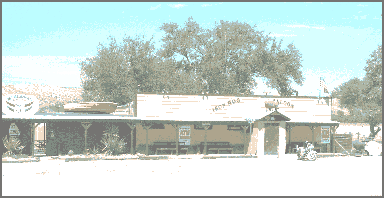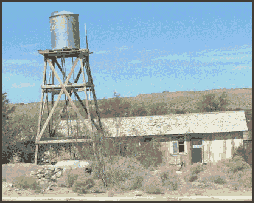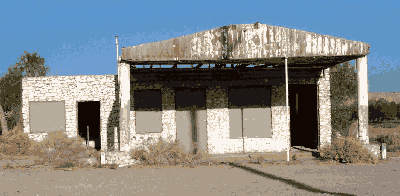

The improvement of the state highway in 1925-26 made travel much easier, and motorists soon took to the roads. Traffic counters at the agricultural inspection station at Daggett kept a tally of cars passing through, and by the end of the decade the numbers were varying from 4,000 to a high of 6,650 automobiles per month.
As traffic increased, roadside businesses cropped up everywhere. Several were opened on Highway 66 between Oro Grande and Helendale beginning around 1931: La Delta, Potapov's, K. T. Smith's, the Sage Brush Inn, and others. These roadside businesses in northern Oro Grande and Helendale were important enough to be mentioned occasionally in a local newspaper column called "HI-WA News" (yes, that was their spelling for hi-way). The Victor Press wrote about events in the area under the heading, "Along the Sagebrush Route."
For those taking the tour, we begin at the underpass just north of the center of Oro Grande, where the odometer is set at zero. The direction is from south to north. While sightseeing, remember that some of these places are private homes, so please stay far enough away to allow the residents some privacy.



0.00 -- Oro Grande Underpass.
This is a good place to start in time as well as space, because the underpass was built by the Santa Fe Railroad in 1925, in cooperation with the State Highway Department's road building project. There was a blind curve at the railroad crossing, thought to be one of the worst in the state. The Highway Department was anxious to get an undercrossing built there, but they had no money.
At the same time, the Santa Fe was realigning and adding to their track, double-tracking they called it, in the same reach. State Engineer E. Q. Sullivan was able to convince the railroad officials that if they would provide an undercrossing for the road, estimated to cost $30,000, the state would reconstruct the highway on a different alignment to allow for the track straightening. The taxpayers certainly got a good deal on this project, and the underpass is still in operation 76 years later.
1.00 -- Danny's Place (east) -- now a residence.
On the east side of the road (this would be on the right as you head towards Helendale) is a little place that used to be a beer bar, but has since been converted into a residence. Johnny Rogers, Sagebrush Annie's boyfriend after her husband died, was killed on the road here when he ran head-on into a big rig. The place was popular in the late 1940s and early ‘50s for birthday parties, anniversaries, and such. Later it got the reputation of catering to a rough crowd.
1.40 -- Iron Hog (west).
Formerly the Lost Hawg, a biker bar. Although it has been redecorated many times, this is one of the early buildings along the highway. It has been owned by the same family since 1944. About that time it housed the dealership for Case farm equipment.
It later became McClintock's Restaurant, and recently has been renamed the Iron Hog, although there is a sign on the highway that refers to the earlier name of Mc Clintock's. The sign was put there to draw attention to the fact that this is an historical site on old Route 66. According to the owner, the structure was built in about 1931.

2.10 -- La Delta (west) -- now a residence.
Originally named Pinky's Service Station. Theodore Simon "Pinky" Ruiz had been a peace officer in San Bernardino, and around 1920 he moved to Oro Grande, where he was the constable. Just exactly when he built the station is not known, but in July 1931 he sold it to Mr. and Mrs. Alva Dickens.
The new owners cleared the land and declared their intention to remodel the building to first-class condition, and to build several cabins to accommodate tourist travel. Like many other roadside businesses on Route 66, they sought to provide attractions for the travelers, something to catch the eye or furnish a diversion while the customers waited for service. The Dickens had a pet Gila Monster, and in the spring of 1932 they planted a cactus garden.
The Mojave Desert may not have appealed to the Dickens family, or the attractions of Los Angeles were too much, because they left in October 1932 and returned home. One legacy they left was the name La Delta, which one author speculated might have to do with the proximity of the Mojave River.
Mr. and Mrs. Casson purchased the business and owned it for several years before selling to Mr. and Mrs. Burge, he being a former employee of Greyhound Bus Company. The Burges began operating the way-stop in August 1937, and stayed open "practically all night as well as all day." Short orders were served with all kinds of drinks, but no beer as yet at the time of their opening.
Mrs. Burge was missing one leg, and local resident Bill Bender remembers her and the place well: "Up on the highway where Highway 66 and Robinson Road met were some buildings, a gas station and a reservoir. You can still see parts of the reservoir and the tower that held the water tank. While my uncle would go in on a hot summer day for a beer, I'd swim in the reservoir and it seemed a mile across even though it's now just a little ol' thing. Maybe it shrunk after standing in the sun all these years."
In later years, Bill stated, "before the freeway came through, [my wife] Helen used to catch the bus there if she was going below. The one-legged lady that ran the place would just hang a red bandana on a nail and that was enough to flag the bus." A gas station and store were located up front next to the highway, but they have since been destroyed.
Still existing at La Delta is a nice example of a 1930s auto court, a forerunner to the modern motel. First came the auto camp in the World War I era. These were very primitive, perhaps just a spot to pull off to the side of the road where you could camp and cook a meal, perhaps pitch a tent. Water may or may not have been provided. Various cities attempted an auto camp within the city limits to promote business, but sanitation and other problems became too great and the practice was discontinued.
The next step in the evolution was the auto court, which provided a structure in a supervised setting, such as a service station with surrounding buildings. Water and sanitary facilities were usually provided, but the latter might consist of a simple outhouse. The structures were very small, intended to take the place of a tent, and hardly seem habitable to today's traveler.
Of course, the ultimate evolution was the modern motel. The changes took place from about 1920 to 1935, so for Route 66 and way-stop afficionados, La Delta is a good spot to study this roadside development.
The U. S. Geological Survey memorialized La Delta by putting the place on its maps, one example being the 15 minute series map published in 1956, entitled "Victorville." To have an area named after a service station and auto court is a bit unusual, at least for this stretch of road, and perhaps it is not all that common elsewhere.

2.50 -- The End of the Trail (east) -- now a residence.
The stone architecture would seem to be that of Helendale and Oro Grande's chief bootlegger, Guy Wadsworth, who built rock houses in the area. It was a commercial building in the past, and you can still see the old half-circle drive that provided access for the customers. One of its architectural points is the striking wagon wheel window next to the front door.
Oro Grande resident Ovie Corrington knew it as the Kootchie Koo bar, the informal name her brother and brother-in-law gave it in 1942. They were staying with the Corringtons, working on the farm as they waited to be inducted into the Navy. They dropped into the place for a beer now and then, and one of the popular tunes they sang in the bar was "Five Foot Two, Eyes of Blue." One of the lyrics went:
4.80 -- Jim's Package Store (east).
A little shop that sold wine.
5.25 -- Elva's Malt Shop (west) -- now a residence.
The first structure at this site is where well-known Victorville resident Fred Bosch retired. The next few houses to the north were built by K. T. Smith and these are where the Smith family lived. The last structure, the one painted white with green trim, was Elva's Malt Shop.
After World War II, with the rationing of fuel and tires a thing of the past, traffic increased and in 1946 rancher K. T. Smith saw an opportunity to build a commercial development to supplement his income. He built the malt shop next to his Happy Days Ranch, and the place became locally famous for its "frosties." Mrs. Smith also specialized in orange juice, which up to that time had not been readily available along the highway.
The building was described as being painted in a cool green shade with just a touch of red to catch the eye, which was a veritable invitation for the tired motorist to "pause and refresh." The business was named after the Smiths' daughter.
5.35 -- Potapov's Service Station (west).
Another significant place along the road is Bill Potapov's (p'-TOP- off's) Service Station. Bill and his family came in 1943, and like those who preceded them, the press recognized their arrival and welcomed the newcomers: "Twin calves born at Wm. Potapor's [sic] ranch. Mr. P has just purchased the B. A. Freeny ranch, getting off to a flying start."
Bill was another one of those interesting characters attracted to Route 66. He dealt in Douglas gasoline, a popular brand of the 1950s. Customers would often pull into his station needing gasoline, or a minor repair, and the driver would be broke (this was before credit cards).
Bill had a big heart and often got stung when he advanced these people gasoline or services on the promise that they would return some day in the future. His solution was to secure something off of the car to act as collateral until the debt was paid--an automotive pawn shop, in effect. As a result his place was soon festooned with car radios, spare tires, bumpers and all manner of car parts.
Potapov's structures--the service station, two auto court buildings and a water tower--are among the most picturesque along the highway. They are excellent examples of Guy Wadsworth's style. Automobiles are often parked alongside the road in front of them as travelers try to penetrate the veil of time and solve the mystery of the stone buildings.
Within the recent past, the roof on one of the motel rooms and also the one on the main building collapsed. The fading sign out front can still barely be made out as "Bill's Service." Just north of the service station is a concrete slab. The slab does not look all that big, but Helendale resident Mirl Orebaugh remembers it as a fairly large garage that had stalls. In the back can be seen the remains of a barn that burned down. The rest rooms are still standing at the northwest corner of the lot. Just north of Potapov's is a slab which is all that is left of a lemonade stand.
This way-stop was quite a draw in the period when the Las Vegas traffic was at its height. Caravans of cars would stop and the place would get quite lively.

6.35 -- Sage Brush Inn (west) -- now a residence.
The roadhouse owned by George and Elizabeth (Sagebrush Annie) Sibert.
6.35 -- Winters' Place (east) -- now a residence.
Harold and Anita Winters were relatives of Sagebrush Annie, and they built their place across the highway from the Sage Brush Inn in 1934. It was a beer bar in the early period and the scene of many madcap adventures, according to Bill Bender.
Bill said the business had a bar that was 36 feet long, but it was destroyed by a recovering alcoholic who was left in charge to watch over things. The alcoholic fell off the wagon, chopped up the bar and sold it to Sagebrush Annie for firewood in order to buy some liquor.
6.50 -- Vondettums' Place (west) -- now a residence.
George and Minnie Vondettum were friends of the Siberts, and Sagebrush Annie talked them into coming to the desert to live next door. Minnie is well remembered for her desert poetry. The original block buildings are still there but are small and hard to see amid the more modern structures.
6.50 -- White Orange Cafe (east).
By August 1946, James G. Blaine and his wife and daughter had their White Orange Cafe in operation. The name is thought to have derived from the family's coat of arms.
That the Las Vegas set was using the highway is shown by a minor incident in 1948 involving dancer/actor Gene Kelly. It is said that Gene stopped in for one of Mrs. Blaine's famous chicken dinners, and while waiting for the order to be prepared he put his feet up on a chair. Mrs. Blaine gave him a major bawling out, and Gene apologized.
Besides the cafe there are some motel buildings out in back. This is the first cafe/motel to be built following the county's adoption of a building code, sometimes referred to as the "anti-shack ordinance," and the difference in the quality of construction from what was built before is striking. The building is now an antique store. In the back can be seen the motel buildings, which have been converted into rentals.

7.50 -- Watson's Richfield Station (east).
This was a Richfield Station and an auto repair garage built by Dr. Bill Watson and his wife Annette. It was open during the heyday of the Las Vegas traffic.
8.20 -- Polly Gas Station Sign (west).
The concrete slab can be seen where Polly gas was sold. The place went out of business after the freeway was built, but the old sign is a reminder of gasoline prices in the 1950s. The original owner of this station was also Dr. Watson. The current owner states that he restored the existing sign.
Next to it on the north is the Helendale store and beer bar. In the early days it was called the Gables. North of the Gables is RV Realty, which at one time was the Helendale Post Office (1957-1986).
8.35 -- Vista Road (west).
9.20 -- Burden's Store (east).
This is a great building with which to end the tour. It was built in early 1926 on the newly-graded state highway alignment, but before the road was paved, which makes it the oldest building on this stretch of the highway.
There was a previous store owned by Postmaster Walter Trickey. In 1924 Trickey's store was mentioned in an advertisement for places around the Victor Valley area that sold Red Crown gasoline, Standard of California's brand.
The ad shows there were several commercial facilities in Oro Grande, but north of that were only Trent Penland's place in Bryman and Trickey's store in Helendale. Not much is known of the Penland operation; he probably sold gasoline from his ranch. Since no other businesses along this strip of road are listed in the newspaper of the time, it is possible that there were no commercial establishments, except for Penland's, between Oro Grande and Helendale until Pinky's Service Station (later La Delta) was built.
Newberry businessman J. W. Burden bought Trickey's store in January of 1926, and his son Charles operated it. Two weeks later it was announced that the store and everything in it had burned. The Burdens rebuilt immediately, using red bricks, so that it still stands to this day.
Charles C. Burden became the Postmaster following Trickey and, sadly, he lost his young wife to a heart ailment in 1929. His father died the following year. The store was very successful economically, and for many decades this was the center of Helendale.



 PAGE
1|
2|
3|
4|
5
PAGE
1|
2|
3|
4|
5